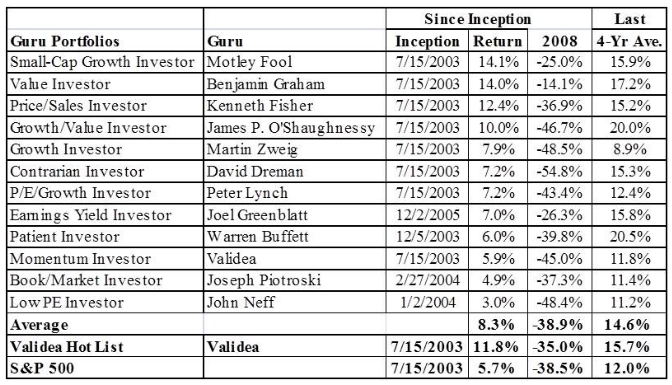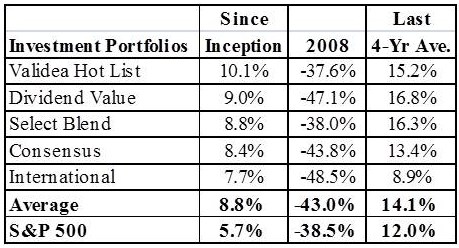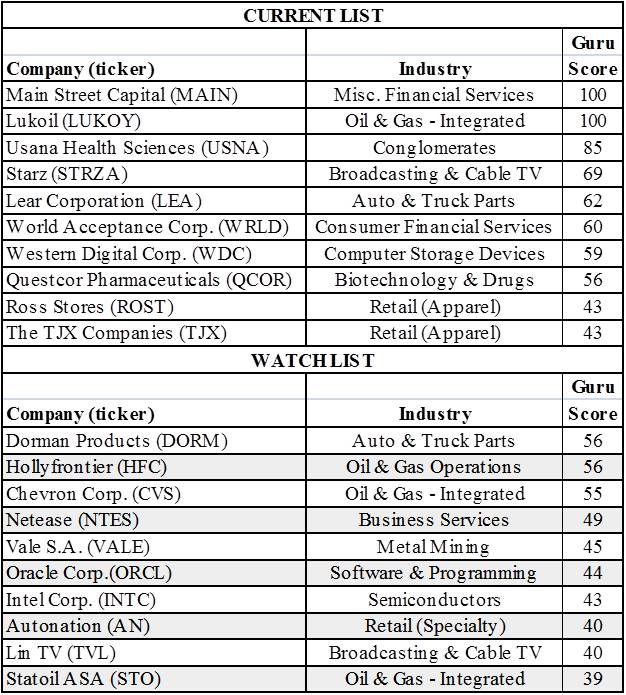It is well documented that picking individual stocks is not a good bet.[1] Market prices do a pretty good job at reflecting all available information, and when new information becomes available, you are not likely to be able to act on it before others. And having more than one stock in your portfolio reduces risk. That is why most people use investment vehicles that include a number of stocks, e.g., mutual funds or indices that reflect a group of stocks, e.g., ETFs.
But there remain a lot of stock pickers. I am one of them. I enjoy beating the market as I did in 2012 with Brookfield Asset Management (BAM +35%). I talk less about picks that don’t do so well, e.g., my purchase of Allied Irish Banks (AIB) before the Irish banking collapse in the second half of 2008. But rational or not, stock picking continues, and for those of you that do it, I urge you to take a look at Validea.
The Evolution of Validea
John Reese, its founder, has an undergrad degree from MIT in electrical engineering (where he got involved in its Artificial Intelligence Lab) and an MBA from Harvard Business School. John became interested in investing, who were good at it and why. He ended up writing a book about them – “The Guru Investor: How to Beat the Market Using History’s Best Investment Strategies”. In it, he describes the investment strategies of each of his gurus: Benjamin Graham, John Neff, David Dremen, Warren Buffett, Peter Lynch, Kenneth L. Fisher, Martin Zweig, James O’Shaughnessy, Joel Greenblatt, and Joseph Piotroski.
Reese took it further: drawing on his background in artificial intelligence at MIT, he developed computer programs modeling the strategy of each guru. And Validea uses these programs to “pick stocks” for each guru. Of course, they are only Reese’s interpretation of how “his gurus” would pick stocks, but it does make interesting reading. Reese added two other computer-generated gurus/models to those listed in the book: Validea’s Momentum and Motley Fool. A spokesman for Validea explained why these were added: “One of the side benefits of both the Fool and the Momentum models is that they are growth and momentum based, which is nice because it offers a little style diversity from the value oriented approaches of most of the models on the site.”
Validea started in 2003, and the web site provides detailed performance data on all his gurus’ stock picks since then. Table 1 provides the performance data on the gurus for the periods: since inception, 2008, and the last five years. The Validea Hot List, ten stocks that rate highest among all gurus, is also included.
Table 1. – Validea Guru Performance
There are several points worth noting:
- Since inception, only two gurus (Piotroski and Neff) have not beaten the S&P while the performance of 3 gurus and the Validea Hot List have more than doubled it.
- 2008 has been included as a year as a reminder of just how bad things got. The S&P fell almost 40%. At the time, I estimated global capital losses at $52 trillion which is extremely significant when you consider 2008 GDP was $61 trillion. The cutback in investment and consumption expenditures resulting from such capital losses pitched the world into recession. 2008 was not a good guru year: only 5 of the 12 guru portfolios and the Hot List did less badly than the S&P.
- In the most recent four years, the S&P 500 barely outperformed Piotroski, Neff, and Validea (Momentum). It did significantly better than Zweig. The remaining gurus and the Hot List outperformed the index.
Table 2 provides selected financial statistics on the guru portfolios. The EPS growth of most portfolios is notable. The annual turnover rates are high inasmuch as the portfolios are “rebalanced” every month. Such high rates are a bit out of character for Reese who preaches a long term perspective for investors.
Table 2. – Guru Portfolio Statistics
Managed Funds
Reese also has funds he manages for investors. Their performance is presented in Table 3. Since inception, all of the managed funds have beaten the S&P benchmark. In the last four years, all but the International Fund have beaten the benchmark.
Table 3. – Validea Managed Fund Performance
Selected statistics for the managed funds are presented in Table 4. The averages are quite similar to the guru portfolios except for the turnover rates. The Hot List Fund is managed in the same manner its guru equivalent.
Table 4. – Managed Fund Statistics
On the Validea web site, you can get complete current and past performance data on all guru investment portfolios. The site also allows you to enter the ticker symbol of any stock that is of interest to find out how each guru rates it.
Peter Lynch – An Aside
I was growing up in Boston when Peter Lynch took over Fidelity’s Magellan Fund (FMAGX). What Lynch did with it was amazing. From 1977 until he “retired” in 1990 at 46, Magellan’s value grew at a 26.4% annual rate versus the S&P 500 (13.3%). When Lynch took over, Magellan’s assets were under $100 million. When he retired, they exceeded $100 billion. I remember him saying once in an interview “Buy what you know about. If you are a housewife, look around when you are shopping and invest in products you like.” Reese documents Lynch’s interest in and use of the P/E/G ratio. I remember that Lynch as not so much a stock picker as an industry picker. If he liked an industry, he would instruct his buyers to purchase “the Industry”.
The Hot List Newsletter
Every 2 weeks, Validea puts out the “Hotlist News Letter”. Reese starts it by writing an excellent round up and interpretation of economic data. In fact, his summary along with the Treasury’s Monthly Statistics and The Economist are my primary sources of economic information. In his February 15th newsletter, he pointed out that the Labor Department just revised US private sector 2012 job growth upward by 335,000, meaning the US economy added 2.25 million jobs in 2012. He also research findings that indicate people who check their portfolios often do not do as well as those who check their portfolios less frequently. He also indicated his top guru portfolios grew by 13.3% annually since 2003 while the S&P 500 has only gained 4.5%. He then looked at the percentage of up days for his guru funds relative to the S&P 500. They were very similar: Guru up days – 52%, S&P up days – 48%. The conclusion: don’t get diverted by good or bad days – all investments many of both.
The other interesting feature of the Hot List newsletter are the “Current List” – top 10 stocks picked by the gurus – and the “Watch List” – the next 10 guru stock picks. These stock picks are always worth considering. The Current and Watch List are presented below.
Conclusions
As indicated at the outset, picking stocks is a losing game for most individuals. But if you believe you are special, the exception to the rule, you should take a look at Validea. Am I recommending that you use Validea to pick stocks? No, but I do think that looking at their Hot List Newsletter every so often is very worthwhile. I have been reading it for last decade.
